
Learn more about Charles Dickens:
Yorkshire Field Trip
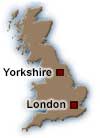 Cheap boarding schools in Yorkshire were advertised in the London papers with an emphasis on 'no holiday' and were a convenient place to dispose of unwanted or illegitimate children. Charles Dickens and his illustrator Hablot Browne phiz) traveled incognito to Yorkshire on a fact-finding mission in January 1838. There they encountered William Shaw, headmaster of Bowes Academy, in whose school several boys had died or went blind from mistreatment and neglect.
Cheap boarding schools in Yorkshire were advertised in the London papers with an emphasis on 'no holiday' and were a convenient place to dispose of unwanted or illegitimate children. Charles Dickens and his illustrator Hablot Browne phiz) traveled incognito to Yorkshire on a fact-finding mission in January 1838. There they encountered William Shaw, headmaster of Bowes Academy, in whose school several boys had died or went blind from mistreatment and neglect.
Visiting a cemetery in the area Dickens found the graves of many of the students of these schools and one in particular Dickens said "put Smike into my head". Smike was the abused inmate of Dotheboys Hall, the fictional school he based on Shaw's Bowes Academy in Nicholas Nickleby. The fictional headmaster of Dotheboys Hall, Wackford Squeers, was based on William Shaw (Ackroyd, 1990, p. 249-252).
The ignorance of the schoolmaster Squeers is more than a comic exaggeration. Edgar Johnson, in his biography of Dickens, notes that as late as 1851, 2.5 per cent of the schoolmasters and mistresses in private schools signed their census returns with a mark (Johnson, 1952, p. 291).
 Herb Moskovitz presents an overview of the theatrical life of Charles Dickens and his theatrical friends and characters.
Herb Moskovitz presents an overview of the theatrical life of Charles Dickens and his theatrical friends and characters.
Dying of a Broken Heart
 Dickens loves to have people die of a broken heart and when Mrs Nickleby says that her husband has succumbed to this malady Ralph Nickleby has an opinion on the subject:
Dickens loves to have people die of a broken heart and when Mrs Nickleby says that her husband has succumbed to this malady Ralph Nickleby has an opinion on the subject:
'Pooh!' said Ralph, 'there's no such thing. I can understand a man's dying of a broken neck, or suffering from a broken arm, or a broken head, or a broken leg, or a broken nose; but a broken heart!—nonsense, it's the cant of the day. If a man can't pay his debts, he dies of a broken heart, and his widow's a martyr' (Nicholas Nickleby, p. 23).

William Macready
 The theater is central to the plot of Nicholas Nickleby and Charles Dickens dedicated the novel to his friend, distinguished actor and theater manager, William Macready.
The theater is central to the plot of Nicholas Nickleby and Charles Dickens dedicated the novel to his friend, distinguished actor and theater manager, William Macready.
Mar 1838 - Sep 1839
Dickens' age: 26-27
March 1838
Daughter Mary (Mamie) Dickens born. Dickens wrote to his publisher, Richard Bentley: "We were all right here at One o'Clock this morning, when I had an instalment of posterity in the shape of a daughter" (Letters, 1965, v. 1, p. 384).
November 1838
Oliver Twist published in 3 volumes. Dickens revised the monthly parts for the publication which was the first published under Charles Dickens instead of Boz. Monthly serialization of Oliver
Twist in Bentley's Miscellany continues (Schlicke, 1999, p. 429).
Visiting Manchester with Hablot Browne, Dickens meets Daniel and William Grant, originals for the Cheeryble brothers in Nickleby (Ackroyd, 1990, p. 273).
February 1839
Resigns as editor of Bentley's Miscellany (Johnson, 1952, p. 248-249).
April 1839
Oliver Twist Serialization concluded in Bentley's Miscellany (Schlicke, 1999, p. 429).
Rents a cottage in Petersham for four months (Ackroyd, 1990, p. 286).
June 1839
Goes to the races at Hampton, scene of the quarrel between Mulberry Hawk and Lord Frederick in Nickleby (Slater, 2009, p. 133).
Dickens' publishers, Chapman and Hall, commission artist Daniel Maclise to paint a portrait of Dickens. Maclise goes to Petersham where Dickens sits for the portrait known as the Nickleby Portrait, an engraving of the portrait used as the frontispiece for the novel (Slater, 2009, p. 133).
September 1839

Nicholas Nickleby locations in Britain

(2002)
Excellent retelling of one of Dickens' best. Starring Charlie Hunnam, Nathan Lane and Christopher Plummer.
EDUCATION. -- At Mr Wackford Squeers's Academy, Dotheboys Hall, at the delightful village of Dotheboys, near Greta Bridge in Yorkshire, Youth are boarded, clothed, booked, furnished with pocket-money, provided with all necessaries, instructed in all languages living and dead, mathematics, orthography, geometry, astronomy, trigonometry, the use of the globes, algebra, single stick (if required), writing, arithmetic, fortification, and every other branch of classical literature. Terms, twenty guineas per annum. No extras, no vacations, and diet unparalleled. Mr Squeers is in town, and attends daily, from one till four, at the Saracen's Head, Snow Hill. N.B. An able assistant wanted. Annual salary 5 pounds. A Master of Arts would be preferred (Nicholas Nickleby, p. 26).
Excerpt:
There once lived, in a sequestered part of the county of Devonshire, one Mr Godfrey Nickleby: a worthy gentleman, who, taking it into his head rather late in life that he must get married, and not being young enough or rich enough to aspire to the hand of a lady of fortune, had wedded an old flame out of mere attachment, who in her turn had taken him for the same reason. Thus two people who cannot afford to play cards for money, sometimes sit down to a quiet game for love (Nicholas Nickleby, p. 1).

Charles Dickens'
Nicholas Nickleby
Nicholas Nickleby - Containing a Faithful Account of the Fortunes, Misfortunes,
Uprisings, Downfallings and Complete Career of the Nickelby Family
Nicholas Nickleby - Published in monthly parts Mar 1838 - Sep 1839
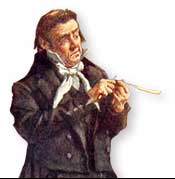
Wackford Squeers by Harold Copping
Charles Dickens' third novel was illustrated by Hablot Knight Browne (Phiz). Dickens and Browne, traveling under assumed names, visited the notorious boarding schools in Yorkshire to do background research for the novel (Forster, 1899, v. 1, p. 112-113), which deals with the mistreatment of children sent to these schools. Although the central theme takes on this serious subject, Dickens mixes in some of his best comic writing.
Dickens biographers George Gissing and G.K. Chesterton praised the comic characterization of the novel (Schlicke, 1999, p. 408), and Peter Ackroyd, in his biography Dickens, says that Nicholas Nickleby is "perhaps the funniest novel in the English language" (Ackroyd, 1990, p. 262).
Plot
(contains spoilers)
Hoping to provide support for his mother and sister after the death of his father, Nicholas Nickleby turns to his uncle, Ralph Nickleby, for assistance.
Ralph wants nothing to do with his late brother's family and feigns to help Nicholas by securing a position as assistant master at the Dotheboys Hall school in Yorkshire run by unscrupulous Wackford Squeers. Nicholas soon becomes disgusted with Squeers' treatment of his pupils and leaves, giving Squeers a sound thrashing, and liberating Smike whom Squeers has mistreated for years.
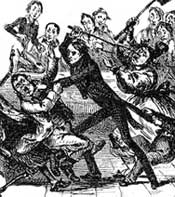
Nicholas thrashes Squeers at Dotheboys Hall by Phiz
Nicholas and Smike move in with Ralph Nickleby's clerk, Newman Noggs, in London and then travel to Portsmouth where they take up acting in Vincent Crummles' touring stage company.
On hearing of the mistreatment of his sister, Kate, at the hands of his uncle, Nicholas and Smike return to London. Nicholas secures employment with the philanthropic Cheeryble brothers and helps rescue Madeline Bray from the evil designs of his uncle and Arthur Gride.
Smike dies from the years of abuse suffered at Squeers' school and is found to be Ralph Nickleby's son. Meanwhile, Ralph is ruined financially and hangs himself. Squeers is sentenced to transportation, his school is disbanded, and Nicholas marries Madeline Bray.
Nickleby Family Tree
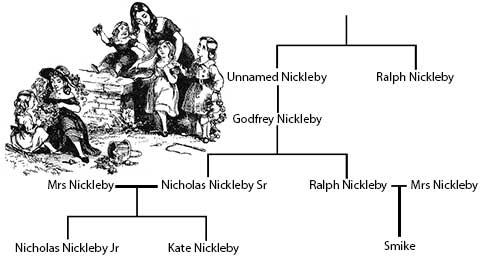
Back to Top 
Complete List of Characters:
Character descriptions contain spoilers
Adams, Captain
African Swallower
Alphonse
Belling
Belawney, Miss
Bevan, Mrs
Biffin, Miss
Blockson, Mrs
Bolder
Bobster, Cecilia
Bobster, Old
Bonney, Mr
Borum, Mr and Mrs
Bravassa, Miss
Bray, Madeline
Bray, Walter
Brooker, Mr
Brooks
Browdie, John
Browndock, Miss
Bulph
Cabbery
Cheeryble, Charles
Cheeryble, Edwin (Ned)
Cheeryble, Frank
Chopkins, Laura
Chowser, Colonal
Clark, Mrs
Cobbey
Cropley, Miss
Crowl, Mr
Crummles, Vincent
Crummles, Mrs
Crummles, Percy
Crummles, Master
Crummles, Ninetta
Curdle, Mr
Curdle, Mrs
Cutler, Mr and Mrs
Dabber, Sir Dingleby
David
Dibabs, Jane
Dick
Digby
Dorker
Dowdles, The Two Miss
Fluggers
Folair, Augustus (Tommy)
Gallanbile, Mr
Gazingi, Miss
|
George
Glavormelly, Mr
Graymarsh
Green, Miss
Gregsbury, Mr
Gregsbury, Mrs
Gride, Arthur
Grimble, Sir Thomas
Grudden, Mrs
Hannah
Hawk, Sir Mulberry
Hawkins
Jenkins
Jennings
Johnny
Johnson, Mr
Kenwigs, Lillyvick
Kenwigs, Morleena
Kenwigs, Mr
Kenwigs, Susan
Knag, Miss
Knag, Mortimer
La Creevy, John
La Creevy, Miss
Lambert, Daniel
Lane, Miss
Ledrook, Miss (Led)
Lenville, Mrs
Lenville, Thomas
Lillyvick, Mr
Linkinwater,Tim
Lukin
Lumbey, Mr
Mallowford, Lord
Mantalini, Alfred
Mantalini, Madame
Marker, Mrs
Matthews
Mobbs
Mogley
Murphy
Nickleby, Godfrey
Nickleby, Mrs Godfrey
Nickleby, Kate
Nickleby, Mrs Nicholas
Nickleby, Nicholas Sr
Nickleby, Nicholas
Nickleby, Ralph (1)
Nickleby, Ralph
Nickleby, Mrs Ralph
|
Noggs, Newman
Palmer
Peltirogus
Petowker, Henrietta
Phoebe (Phib)
Pitcher
Pluck, Mr
Price, Matilda
Pugstyles, Mr
Pupker, Sir Matther
Pyke, Mr
Richard
Rogers
Ruddle
Scaley, Mr
Simmonds, Miss
Slammons, Mr
Sliderskew, Peg
Smifser
Smike
Snawley, Mr
Snawley, Mrs
Snevellicci, Miss
Snevellicci, Mr
Snevellicci, Mrs
Snewkes, Mr
Snobb, Mr
Snuffim, Sir Tumley
Sprouter
Squeers, Wackford
Squeers, Mrs
Squeers, Wackford Jr
Squeers, Fanny
Swallow
Thomas
Timberry, Snittle
Tipslark
Tix, Tom
Tom
Tomkins
Trimmers, Mr
Verisopht, Lord Frederick
Watkins, Mr
Westwood
William
Wititterly, Henry
Wititterly, Julia
Wrymug, Mrs
|
Back to Top 
Nicholas Nickleby Links:
Bartleby.com
Robert Giddings review of the 2002 film version
Wikipedia - Nicholas Nickleby
The Cheeryble Brothers
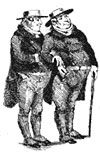 The story of the benevolent brothers who aid Nicholas and his family resulted in Charles Dickens getting hundreds upon hundreds of applications for loans, gifts, and other requests for aid to be forwarded to the originals of the Cheeryble brothers. In the preface to the Cheap Edition of Nicholas Nickleby in 1848 Dickens claimed that the brothers were based on real persons "with whom I never interchanged any communication in my life" (Nicholas Nickleby, p. xix). Paul Davis in The Penguin Dickens Companion says that the brothers were based on William and Daniel Grant, Manchester calico merchants whom Dickens met in 1838 (Davis, 1999, p. 58).
The story of the benevolent brothers who aid Nicholas and his family resulted in Charles Dickens getting hundreds upon hundreds of applications for loans, gifts, and other requests for aid to be forwarded to the originals of the Cheeryble brothers. In the preface to the Cheap Edition of Nicholas Nickleby in 1848 Dickens claimed that the brothers were based on real persons "with whom I never interchanged any communication in my life" (Nicholas Nickleby, p. xix). Paul Davis in The Penguin Dickens Companion says that the brothers were based on William and Daniel Grant, Manchester calico merchants whom Dickens met in 1838 (Davis, 1999, p. 58).
Charles Dickens Describes the Boys at Dotheboys Hall
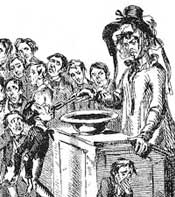
Mrs Squeers dosing the boys with treakle and brimstone
There were little faces which should have been handsome, darkened with the scowl of sullen, dogged suffering; there was childhood with the light of its eye quenched, its beauty gone, and its helplessness alone remaining (Nicholas Nickleby, p. 88).
How many boys were boarded at Dotheboys Hall?
Squeers says: There's youth to the amount of eight hundred pound a year at Dotheboys Hall at this present time. I'd take sixteen hundred pound worth if I could get 'em, and be as fond of every individual twenty pound among 'em as nothing should equal it!' (Nicholas Nickleby, p. 437) So roughly 40 boys.
Back to Top 

 The story of the benevolent brothers who aid Nicholas and his family resulted in Charles Dickens getting hundreds upon hundreds of applications for loans, gifts, and other requests for aid to be forwarded to the originals of the Cheeryble brothers. In the preface to the Cheap Edition of Nicholas Nickleby in 1848 Dickens claimed that the brothers were based on real persons "with whom I never interchanged any communication in my life" (Nicholas Nickleby, p. xix). Paul Davis in The Penguin Dickens Companion says that the brothers were based on William and Daniel Grant, Manchester calico merchants whom Dickens met in 1838 (Davis, 1999, p. 58).
The story of the benevolent brothers who aid Nicholas and his family resulted in Charles Dickens getting hundreds upon hundreds of applications for loans, gifts, and other requests for aid to be forwarded to the originals of the Cheeryble brothers. In the preface to the Cheap Edition of Nicholas Nickleby in 1848 Dickens claimed that the brothers were based on real persons "with whom I never interchanged any communication in my life" (Nicholas Nickleby, p. xix). Paul Davis in The Penguin Dickens Companion says that the brothers were based on William and Daniel Grant, Manchester calico merchants whom Dickens met in 1838 (Davis, 1999, p. 58).
 Cheap boarding schools in Yorkshire were advertised in the London papers with an emphasis on 'no holiday' and were a convenient place to dispose of unwanted or illegitimate children. Charles Dickens and his illustrator
Cheap boarding schools in Yorkshire were advertised in the London papers with an emphasis on 'no holiday' and were a convenient place to dispose of unwanted or illegitimate children. Charles Dickens and his illustrator  Dickens loves to have people die of a broken heart and when
Dickens loves to have people die of a broken heart and when 






